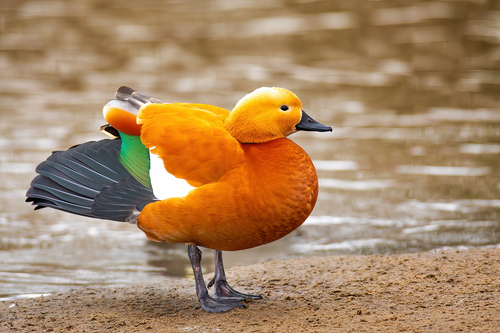
Ruddy Shelduck
The Ruddy Shelduck (*Tadorna ferruginea*) is a striking waterfowl species known for its vibrant orange-brown plumage and distinctive white wing patches visible in flight. It occupies a unique ecological niche, often found in inland wetlands and high-altitude lakes across a vast range. The species holds cultural significance in some regions, appearing in Buddhist iconography and folklore. Its adaptability allows it to thrive in diverse environments, playing a role in seed dispersal and nutrient cycling within its habitats.
58-70 cm
Length
110-135 cm
Wingspan
Least Concern
Conservation Status
Distribution
The Ruddy Shelduck has a broad distribution, breeding across southeastern Europe, Central Asia, and parts of North Africa. Significant populations winter in South Asia, particularly India. They exhibit altitudinal migration, moving from high-altitude breeding grounds to lower elevations in winter.
Lifespan
Up to 15 years in the wild; potentially longer in captivity. (Not Evaluated - Limited long-term data)
Ruddy Shelduck's Habitat
Habitat Types
Inland wetlands, Brackish and saline lakes, Rivers, Steppe grasslands, High-altitude lakes and marshes
Climate Zones
Temperate, Arid, Semi-arid
Adaptations
Ruddy Shelducks are well-adapted to harsh environments. They can tolerate high salinity levels in water bodies and are capable of long-distance flights over mountainous terrain. Their dense plumage provides insulation in cold climates.
Variations
No recognized subspecies, but slight variations in plumage intensity and size have been observed across their range. These are not considered significant enough to warrant subspecific classification.
Appearance
Breeding Plumage
Plumage is generally consistent year-round. During the breeding season, males develop a narrow black neck ring, which is absent or less pronounced in non-breeding birds and females.
Seasonal Feather Changes
Minor changes, mainly related to the intensity of the orange-brown coloration and the presence/absence of the male's neck ring.
Sex Based Plumage Differences
Males have a black neck ring during breeding season; females lack this ring. Females may have slightly duller plumage overall.
Notable Features
Bright orange-brown body plumage, White wing patches (prominent in flight), Black flight feathers and tail, Pale head and neck, Black bill and legs
Diet and Feeding
Primary Foods
Grasses, Seeds, Aquatic plants, Invertebrates (insects, crustaceans, mollusks), Small fish (occasionally)
Foraging Behavior
Ruddy Shelducks graze on land and dabble in shallow water. They also up-end to reach submerged vegetation. They are often seen foraging in pairs or small groups.
Specializations
Their bill has serrated edges, which are adapted for grasping and tearing vegetation.
Seasonal Diet Variations
Diet varies depending on food availability. During the breeding season, they may consume more invertebrates to meet the protein requirements of egg-laying and chick-rearing. In winter, they rely more heavily on plant matter.
Behavior
Social Structure
Generally found in pairs or small family groups during the breeding season. Outside of breeding, they can form large flocks, sometimes numbering in the hundreds or even thousands.
Communication
Loud, honking calls (often described as 'trumpet-like'), Visual displays (head-bobbing, wing-flapping), Whistling sounds
Migration
Many populations are migratory, undertaking long-distance movements between breeding and wintering grounds. Some populations are resident or only partially migratory.
Territorial or Group Behaviors
During the breeding season, pairs are territorial, defending their nesting site and surrounding area. Outside of breeding, they are more gregarious and form large flocks.
Conservation
Threats
Habitat loss and degradation (due to wetland drainage, agriculture, and development), Hunting (in some regions), Disturbance at breeding sites, Climate change (potentially affecting water availability and breeding success)
Protection Programs
Listed under the Agreement on the Conservation of African-Eurasian Migratory Waterbirds (AEWA), Protected in many countries within its range through national legislation
Local National Laws
Varies by country; many countries have laws protecting migratory birds and their habitats.
Population Trend
Stable
Population Estimates
Global population estimated to be between 170,000 and 220,000 individuals.
Interesting Facts
They are considered sacred in some Buddhist cultures.
Often depicted in art and associated with longevity and fidelity.
They can nest far from water.
Nests can be located several kilometers from the nearest water source, requiring chicks to undertake a long journey to reach feeding areas.
Ruddy shelducks are known for their aggressive behavior.
Especially during the breeding season, when they will fiercely defend their territory and young.
Faqs about Ruddy Shelduck
Are Ruddy Shelducks good to eat?
While they are hunted in some regions, their flesh is not considered particularly palatable by many people. Hunting regulations vary by country.
Do Ruddy Shelducks mate for life?
They are generally monogamous, forming pair bonds that often last for multiple breeding seasons. However, 'divorce' can occur, and individuals may find new partners if their mate dies.
How can I tell a male Ruddy Shelduck from a female?
During the breeding season, the male has a distinctive black neck ring, which the female lacks. Females also tend to have slightly duller plumage.
Where can I see Ruddy Shelducks?
They can be found in a variety of wetland habitats across their range, including lakes, rivers, and marshes. Consult local birdwatching guides for specific locations.
Copyright @ Nature Style Limited. All Rights Reserved.
 English
English